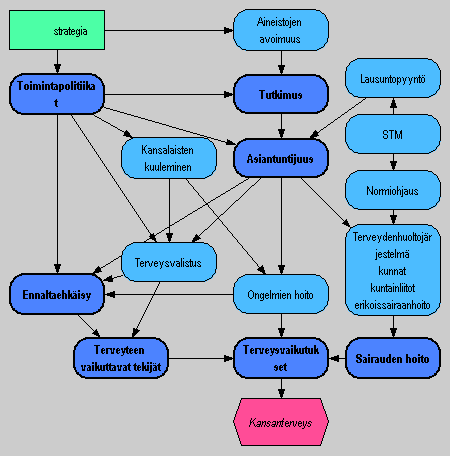Assessment on Institute of Public Health and Welfare
| Moderator:Jouni (see all) |
|
|
| Upload data
|
Assessment on Institute of Public Health and Welfare. See an Analytica model for this assessment:Public health determinants.ANA.
The aim of the assessment on Institute of Public Health and Welfare is to define the properties of such a national institute in general. Any country interested can then adopt the basic solutions and emphasise those parts that are especially important for that country. The institute is expected to be functional for the contemporary world (2009), and the expected life span of the institute is at least 20 years. The institute should be applicable in a developed western society, but the basic concept should be functional enough to be adaptable to a small or a large developing country.
Contents
Scope
Purpose (research question)
What are the main strategic tasks, ways of working, and organisational structure for a governmental institute of public health and welfare (called NIPHW for short) such that the institute
- is capable of fulfilling its purpose and major tasks,
- maintains and develops its expert potantial,
- produces high-quality scientific information,
- maintains capacity to react to emerging threats of public health?
Boundaries
Purpose of the institute
The purpose of the institute is to maintain and promote the health, well-being, and social welfare of the citizens of a nation and also internationally. The institute is a national research and expert institute. It is not directly responsible for maintaining the national health care system or providing health care services, unless some specific tasks are given to the institute on a national level.
Major tasks
The purpose of the institute is fulfilled by
- completing the tasks that are mandated to it in laws and other regulations;
- doing scientific research;
- promoting health and preventing diseases and social discrepancy;
- protecting people against health threats;
- developing the health care system;
- maintaining and developing health-related information systems;
- doing expert work and dissemination among the administration and stakeholders;
- promoting health-related innovations;
- maintaining an efficient management system; and
- acting internationally in the domain of public health and welfare.
Scenarios
None defined.
Intended users
- Ministries of social affairs and health in various countries.
- Existing institutes of public health, social affairs, or welfare.
Participants
- This is an open assessment, therefore anyone interested may participate, if he/she accepts the rules of open assessment.
- Especially, we hope that people from existing similar institutes will participate, as they have practical expertise needed in this work. Possible institutes include, but are not limited to
Definition
Decision variables
- Structure of organisation of NIPHW: Is the organisation based on scientific methods, substance areas, or a mixture?
Indicators
- Scientific information produced by NIPHW.
- Information produced for informing societal decision-making.
- Information produced for citizen health education.
- Development of societal infrastructures to prevent health threats.
- Public health situation in the country.
- Social welfare in the country.
- International recognition of NIPHW.
Value variables
- None defined.
Other variables
Health and welfare research
- Follow-up of the public health situation
Promotion of health and welfare and preventing diseases and social discrepancy
Protection of people against health threats
- Ensuring information about environmental health risks and their abatement
- Ensuring national preparedness to environmental health crises
- Research on major environmental health issues and their abatement
- Creating innovations related to environmental health
- Evaluating and developing standards of activity related to environmental health
Development of the health care system
Maintenance and development of health-related information systems
Expert work and dissemination among the administration and stakeholders
- Promotion of health-related innovations
- What are the areas where specific promotion of innovations are needed?
- Research activity of NIPHW
- Cooperation and R&D at boundaries of disciplines
- Networking of education and innovations
- Strategic centres for research
- What are the strategic areas where there should be a national strategic research centre?
- Promotion of R&D with universities and sister institutes of NIPHW
Maintenance of an efficient management system
International actions in the domain of public health and welfare.
- Departments of NIPHW
- What are the departments of NIPHW? (Dependent on Structure of organisation of NIPHW).
- Dept of chronic diseases
- Dept of infectious diseases
- Dept of environmental health
- Dept of social equity
- Dept of lifestyle diseases
- Dept of developing child
- Dept of
Many tasks of NIPHW are about global issues, infectious diseases as one example. These are best tackled with close inernational collaboration. Many problems, when once solved, can then be tackled using the same approaches worldwide. Therefore, the collaboration about practical problems (which are dealt with by using applied research) should be done using open assessment. This way, all solutions are readily available to all to use and improve.
This approach should be adopted as a strategy for a National Institute of Public Health and Welfare (NIPHW). It can collaborate with other similar institutes using open assessment and thus create synergism in developing and implementing policies.
Issues:
- How the institute is organised so that there is a critical mass of expertise but at the same time enough cross-institutional collaboration?
- How the extramural work is paid for so that it
- is fair compared with the intramural work,
- it has clear criteria about the quality of the work performed
- it has clear criteria about who should be paid for the work done in collaboration?
Indices
- None defined.
Analyses
- None defined.
Result
Results of indicators and analyses
- Not yet available.
Conclusions
- Not yet available.

